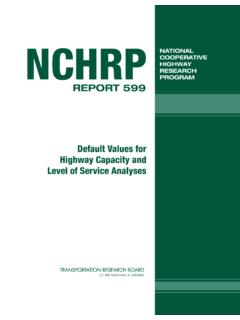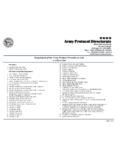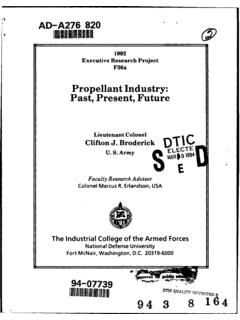Transcription of In Weather Modification - Geoengineering Watch
1 ICAS Report No. 10a November 1966 A Recommended national Program In Weather Modification A Report to the Interdepartmental Committee for Atmospheric Sciences Homer E. Newell bY Associate Administrator for Space Science and Application national Aeronautics Si Space Administration Washington, Interdepartmental Committee for Atmospheric Sciences I w W 0 - a n 0 n Q 0 n E I > 0 0 - m I e. "I.. DONALD F. HORWIG, Chairman Special Assistant to the President for Science and Technology Jowl S. PW!Wt, JR. Department of Defense J. HERBERT HOLUXW Department of Camerce G-T. SEABORG Atdc Energy Camlssion LELAND J. HAwOR!CE Rational Science Foundation PHILIP Re LEE JAMES E. WEBB Department of Health, Education, and national Aeronautics and Space Welfare Administration THCWS F. BATES Department of the Interior EEIWAt? POLLACK (Observer) Department of State WILLLAM F.
2 McKEE (Observer) Federal Aviation Agency JACK W. CARISOH (Observer) Council of Ekonolpic Advisers GEORGEL. MEHRW Department of Agriculture WILLIAM D. CAREX (Observer) Bureau of the Budget HERBFST SCOVIIU, JR. (Observer) Arms Control and Disarmament Agency S. DILLON RIpLey (Observer) Smithsonian Institution CHARtES V. KIDD Executive Secretary J. HEREERT HOLLWNI chsim Federal Council for Science and Technology UZUND J. HAWORTH, Vice Chairman national Science Foundation RO[BERTM. WHITE Department of Camnerce RICHARD A. PRINDU Department of Health, Education, and JOSHUA Z. HaLIdl4D (Acting) Atamic Energy Cammission Welfare HERMAN mucic Department of State LEE mmm Federal Commrnicatlons Caannission SAMUEL A. IAWREEE (Observer) Bureau of the Budget CLAY'IQR E. JWSEN (Observer) Office of the Federal Coordinator for hieteo-ogicd. Services and Su~~orting Research THMlDoRE C.]
3 BmY Department of Agriculture DONALD M. MCARTMm Department of Defense HaMERE. national Aeronautics and Space Administration THaMAs F. BATES De-nt of the Interior JOSEWD. BLATT Federal Aviation Agency DAvlD Z. ROBINSON (Observer) Office of Science and Technology JOHN R. SIEVERS (Observer) national Academy of Sciences smmmw. BETlls Executive Secretary FEDERAL COUNCIL FOR SCIENCE AND TECHNOLOGY INTERDEPARTMENTAL COMMITTEE FOR ATMOSPHERIC SCIENCES DEPARTMENT OF COMMERCE WASHINGTON, 20230 ICAS Report No. 10a November 7, 1966 MEMORANDUM FOR DR. DONALD F. HORNIG Subject: Weather Modification Program At its meeting of March 29, 1966 the Fe~dr61 Council askel ICAS to prepare a report outlining "who is doing what in Weather Modification , the future plans of the agencies (particularly Commerce and Interior) and their interrelationships, and the considerations that should affect decisions on the division of responsibilities for research in Weather Modification .
4 " Forwarded herewith is a Report prepared for ICAS by 3r. Homer E. Newell, the NASA member of ICAS. It has been thoroughly con- sidered by our Committee and is endorsed as the ICAS response to the Council's request above. J. Herbert Hollomon Chairman A Recommended national Program In Weather Modification A Report to the Interdepartmental Committee for Atmospheric Sciences bY Homer E. Newel1 Associate Administrator for Space Science and Applications lVational Aeronadcs A Space Administration Washington, ' 1 October 1966 A RECOMMENDED national PROGRAM IN Weather Modification INTRODUCTION The earth'sJeather has a profound influence on agriculture, forestry, water resources, industry, com- merce, transportation, construction, field operations, commercial fishing, and many other human activities. Adverse effects of Weather on man's activities and the earth's resources are extremely costly, amounting to billions of dollars per year, sometimes causing irreparable damage as when human lives are lost in severe storms.
5 There is, therefore, great motivation to develop effective countermeasures against the destructive effects of Weather , and, conversely, to enhance the beneficial aspects. The financial and other benefits to human welfare of being able to modify Weather to augment water supplies, reduce lightning, suppress hail, mitigate tornados, and inhibit the full development of hurricanes would be very great. Over the past twenty years experiments have been conducted on Weather Modification , particularly on the effects of seedinq clouds with such materials as - silver iodide crystals. The results are limited. Under suitable circumstances it has been possible to augment precipitation by ten to twenty percent, and to reduce the frequency of fire-producing lightning strokes. Effects on hail production have been noted, sometimes suppression and sometimes augmentation.
6 These results probably would be of only passing interest were it not for the potential importance to mankind of further progress in this field. Perhaps the most significant result of the experiments to date has been to bring about a change in attitude from one of skeptici9m to one of cautious optimism. The limited success to date is encouraging, and underscores the 2 importance of pressing forward with the necessary research to understand the dynamics of Weather systems that will have to be dealt with in any efforts at Weather modifica- tion. The gradually accumulating evidence of positive results from efforts at Weather Modification led the Committee on Atmospheric Sciences of the national Academy of Sciences, in November 1963,to appoint a Panel on Weather and Climate Modification "to undertake a deliberate and thoughtful review of the present status and activities in this fieldq and of its potential and limitations for the future.
7 " The Panel made its report at the beginning of this calendar year (Ref. 1). The composition of the NAS Panel is given in App. I, together with a list of the Panel's recommendations. Elaboration and discussion of these recommendations may be found in Ref. 1. On June 16, 1964, the Director of the national Science Foundation announced the appointment of a Special Commission on Weather Modification . in its review of the field, the Commission activated seven subgroups to study the physical, biological, statistical, social, international, legal and legis- lative, and administration and funding aspects of Weather and climate Modification . The membership of the Commission and a list of the principal recommen- dations of the Commission are attached (App. 11). Fdrther elaboration and discussions of those recom- mendations may be found in the Commission's report and the report of the subgroups (Refs.)
8 2 and 3). To assist * Final Report of the Panel on Weather and Climate Modi- fication to the Committee on Atmospheric Sciences, national Academy of qciences- national Research Council; " Weather and Climate Modification ," Volume I-Summary and Recommenda- tions, Publication No. 1350, 1966, pg vii 3 With the growing conviction of positive and poten- tial results, a number of government agencies have been developing plans for research and ultimately operational programs in Weather and climate Modification . Some of these plans stem from the desire to use Weather modifi- cation to meet specific mission responsibilities such as development of water resources, protection of crops, protection against forest fires, ecc: Other plans stem - m dire= responsibility for furthering our under- standing of Weather and its uses. A summary report, "Present and Future Plans of Federal Agencies in Weather -Climate Modification ," dated June 20, 1966, was prepared for the Interdepartmental Committee for Atnospheric Sciences (ICAS) by a Select Panel on Weather Modification (App.
9 111). -Whereas the ICAS Select Panel report reflected a desirable vigor in pressing forward in this important field, nevertheless, it raised a number of questions as to the soundness and adequacy of proposed plans, the validity of cost estimates, the availsbility of trained people to meet the schedules proposed, overlapping of research activities, duplication of proposed facilities, responsibility for coordination and reporting, and responsibility for regulation and control. __ __ To discharge its responsibilities, ICAS must provide answers to these questions and make appropriate recommen- dations. To this end, the Chairman of ICAS, Dr. Herbert Hollomon, asked me to review the proposed plans and to submit recommendations that might be adopted by ICAS for a report to Dr. Donald F. Hornig, Director of the Office of Science and Technology, Executive Office of the President.
10 TERMS OF REFERENCE FOR THIS STUDY The terns of reference for this study are set forth in the memorandum from Dr. Hollomon to me (App. IV), specifically requesting me to formulate a national Weather 4 Modification Program along the lines delineated in the report of the ICAS Select Panel on Weather Modification . APPROACH I have taken the ICAS Select Panel Report (App. 111) as my starting point, and have used the NAS Panel and NSF Special Commission Reports (Refs. 1, 2, 3) as sources of expert thinking on the subject. In order to penetrate in sufficient depth into the problems involved, I put together a panel of NASA experks, the constitution of which is given in App. V. We met a number of times with representatives from the Department of Agriculture, the Environmental Science Services Administration (ESSA), the Interior Department's Bureau of Reclamation, and the national Science Foundation (NSF), to hear briefings on program plans and budgets, to discuss proposed schedules, staffing, facility construction, and operations, and to review in some detail the validity of cost estimates.






